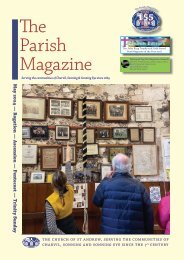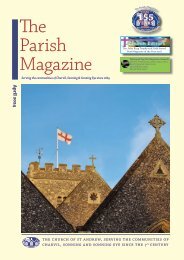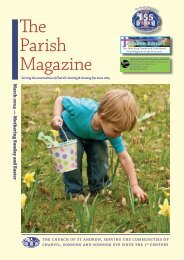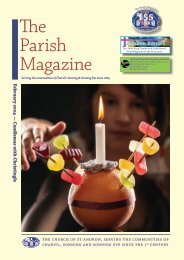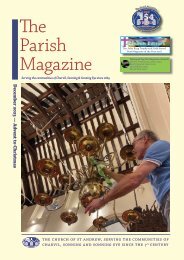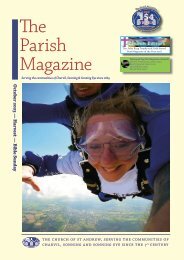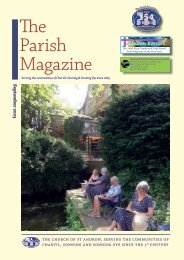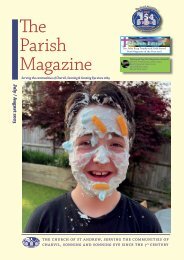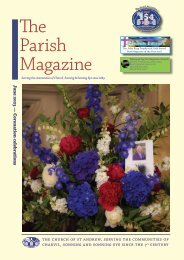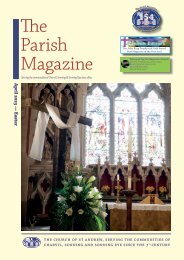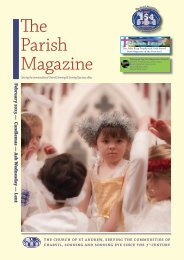The Parish Magazine January 2021
You also want an ePaper? Increase the reach of your titles
YUMPU automatically turns print PDFs into web optimized ePapers that Google loves.
The Parish Magazine - January 2021 37
the sciences HOME & GARDEN — 1
A US scientist’s letter to
the Church in the UK
The year misletoe was
left up on high By Kirsty Steele
Romain Dancre, unsplash.com
By Dr Ruth M Bancewicz, church engagement director at The Faraday
Institute for Science and Religion in Cambridge
I want to share a message of hope that Christians in the
sciences can bring to the church. Dr Francis Collins, who
leads medical research in the US, wrote earlier in the
pandemic about his faith and his hope in God to help us.
He expressed the grief of many, described an intensity of
scientific work he has never experienced before, and shared
his conviction that he is in the right place — serving God
with science. He is holding on tight to the words of Paul in
2 Timothy 1:7, ‘for God gave us a spirit not of fear but of
power and love and self-control.’
POWER: In 2 Timothy the apostle Paul encourages his friend
to ‘fan into flame the gift of God’ that is in him. I am thankful
that scientists, like Francis, are using their own particular
talents to understand Covid-19, and to help prevent or treat
infection. Their discoveries are not only useful, but they can
also display the beauty and wonder of God’s creation.
LOVE: A scientist shows their love for God, for people and all
of creation through their work in the lab. One described his
experiences to me: 'I study God’s fingerprints in his creation to
learn more of him and the world he placed us in and to learn how
we should take care of it and each other…I pray for inspiration
and insight into how his creation works…and that he provides the
opportunities to give the glory to him.'
SELF CONTROL: It is largely our own and others’ selfish
actions that can turn one animal’s friendly virus into our
own personal nightmare. Thankfully Jesus’ suffering, death
and resurrection are the solution to evil. Our ultimate and
certain hope is that one day all Creation will be renewed. We
can also have hope for God is with us in our suffering. When
we respond in positive ways to painful events, it is evidence
that Jesus is alive and working in our lives.
Science will not solve all our problems, but with God’s
help and wisdom we can use the tools of science to serve him
and love others. Let’s pray together for the strength to cope,
and for an end to this pandemic.
Bertold Werkmann, dreamstime.com
The demand for mistletoe this past Christmas should not
have been as great as usual because kissing strangers
under it was strictly taboo. It remains, however a
tradition. Adherents use holly, ivy and mistletoe. While
holly and ivy are to be found in gardens and hedgerows,
mistletoe usually only appears in greengrocers' shops, or
high up in a trees well out of reach. [Examples of this can be
seen in St Andrew's churchyard]
Mistletoe is hemiparasitic, meaning that although its leaves
enable it to feed itself through photosynthesis, its roots
invade the host tree or shrub to extract water and other
nutrients. Its favourite host trees are apple, lime, hawthorn,
poplar or oak and it normally hangs as a large globe,
tantalisingly high and totally visible once winter arrives and
it is the only green left on the tree.
There are some spectacular examples in Windsor Great
Park, clearly visible from the path on the opposite side of the
River Thames.
PEACE, LOVE AND UNDERSTANDING
We all know about the almost translucent white berries,
fleshy and sticky, which form in the forks of mistletoe's many
branches. While they are toxic to humans, they are attractive
to birds. When birds have enjoyed the juicy flesh, they wipe
the remaining seeds off their beaks onto the nearest branch
(somewhat like small children wiping sticky hands on any
surface close by – mummy's face or clothes?). With luck
the seed remains stuck to the bark and solves mistletoe's
problem of reproduction.
In Greek mythology, mistletoe gave access to the
underworld. Romans thought it represented peace, love and
understanding and perhaps that is how it has sidled into our
Christmas celebrations. The earliest documentary evidence
for kissing under mistletoe dates from the 16th Century.
Some people think a berry should be removed after each kiss.
Given the small size of pieces generally available these days,
perhaps that is a practice not to be pursued!




